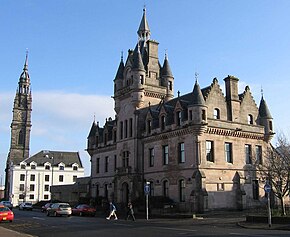
Scottish baronial or Scots baronial is an architectural style of 19th-century Gothic Revival which revived the forms and ornaments of historical architecture of Scotland in the Late Middle Ages and the Early Modern Period. Reminiscent of Scottish castles, buildings in the Scots baronial style are characterised by elaborate rooflines embellished with conical roofs, tourelles, and battlements with machicolations, often with an asymmetric plan. Popular during the fashion for Romanticism and the Picturesque, Scots baronial architecture was equivalent to the Jacobethan Revival of 19th-century England, and likewise revived the Late Gothic appearance of the fortified domestic architecture of the elites in the Late Middle Ages and the architecture of the Jacobean era.
Among architects of the Scots baronial style in the Victorian era were William Burn and David Bryce. Romanticism in Scotland coincided with a Scottish national identity during the 19th century, and some of the most emblematic country residences of 19th-century Scotland were built in this style, including Queen Victoria's Balmoral Castle and Walter Scott's Abbotsford, while in urban settings Cockburn Street, Edinburgh was built wholly in baronial style. Baronial style buildings were typically of stone, whether ashlar or masonry.
Following Robert William Billings's Baronial and Ecclesiastical Antiquities of Scotland, architectural historians identified the stylistic features characteristic of the baronial castles built from the latter 16th century as Scots baronial style, which as a revived idiom architects continued to employ up until 1930s. Scottish baronial was core influence on Charles Rennie Mackintosh's Modern Style architecture.[1] The style was considered a British national idiom emblematic of Scotland, and was widely used for public buildings, country houses, residences and follies throughout the British Empire. The Scottish National War Memorial was the last significant monument of the baronial style, built 1920 in Edinburgh Castle after World War I.[2]
- ^ Charles Rennie Mackintosh, Masterpieces of Art by Gordon Kerr. p. 8.
- ^ Glendinning, Miles; MacKechnie, Aonghus (2019). Scotch Baronial: Architecture and National Identity in Scotland. London: Bloomsbury Publishing. p. 4. ISBN 978-1-4742-8348-9.